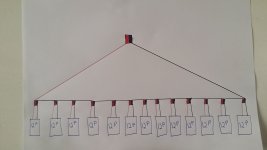Test For Bulk Charge Feasibility
- Test all cells for:
- Self-discharge
- Comparative IR (Internal Resistance)
- Comparative Capacity
1. Carefully balance charge all packs
2. Confirm all cells of equal voltage, test after removed from charger for 1 hour (multi-meter at balance plugs)
label each cell with precise voltage - .01 needed .001 preferred
tape and felt tip marker works
3. Let set several days ... then re-test the voltage of each cell and compare to 1st measure
voltage loss is the
Self-Discharge that must be (eventually) eliminated (some minor loss is to be expected, excessive discharging cells must be eliminated)
4. Connect cells in series ~24s-30s
5. Discharging gently through 2 - 120V 60w light bulbs should provide a 4 hour (1Ah per hour) 1 time evaluation test.
6. At some time into test (1 hour?), measure and note the voltage of each cell.
This is the
Comparative IR (Internal Resistance)
Higher voltage sag indicates poor IR
Exceptionally poor IR cells should be (eventually) eliminated
7. Continue discharge while testing voltage of every cell at intervals
Intervals should become closer as cells near "empty"
("empty" varies with battery brand-model and discharge rate)
Pay closest attention to lowest voltage cell and watch for accelerated voltage loss = discontinue test
8. Let set several minutes
9. Measure and note cell voltages
This indicates
Comparative Capacity
E.G. - (3 hours) 3000mAh + 3.725V (residual V)
Any notably lower cells should be eliminated-replaced - they diminish entire pack capacity
10. Recharge and balance all cells precisely ... again
Run a typical eBike discharge till your considered "empty"
Test each cell and compare voltages >> as a confirmation via higher discharge rate of cells of similar condition-capacity
11. If there are no notably self discharging cells, no cells of deviant IR and all of similar capacity ...
12. Test a bulk charge at ≤.5C (≤2A for 4Ah pack)
13. If cells return to equal beginning voltages at full charge ...
Congratulations!
Your pack is a good candidate for bulk charging (monitoring and occasional balance charges recommended as needed!)
If not ...
Replacing
#1 self-discharging cells
#2 poor IR cell
#3 poor capacity cells
can put you into good condition for bulk charging!



